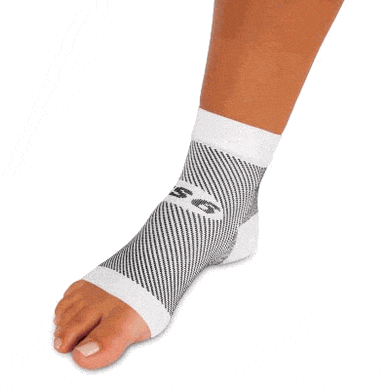Darco Plantar Fasciitis Sleeve Kansas Foot Center
Plantar Fasciitis: Symptoms, Treatment and Prevention

In this final article in both part series on Plantar Fasciitis, Brad Walker talks about the normal symptoms of this painful sports personal injury as well as the utmost effective treatments once diagnosed. Brad also outlines some very important preventative measures that are necessary in avoiding Plantar Fasciitis. A ft . injury such as plantar fasciitis generally occurs in a single foot. Bilateral plantar fasciitis is unusual and tends to be the result of a systemic arthritic condition that is exceedingly rare among sportsmen. Males have problems with a somewhat increased incidence of plantar fasciitis than females, perhaps consequently of higher weight coupled with greater velocity and floor impact, as well as less versatility in the feet.Typically, the sufferer of plantar fasciitis activities pain upon rising after sleep, specially the first step out of foundation. Such pain is firmly localized at the bony landmark on the anterior medial tubercle of the calcaneus. In some cases, pain may prevent the athlete from walking in a normal heel-toe gait, creating an unusual walk as method of compensation. Less common regions of pain are the forefoot, Achilles tendon, or subtalar joint.After a brief period of walking with this kind of feet injury, the pain usually subsides, but returns again either with vigorous activity or prolonged standing or walking. For the field, an transformed gait or abnormal stride pattern, along with pain during running or jumping activities are tell-tale indications of plantar fasciitis and really should be given prompt attention. Further signs of the injury include poor dorsiflexion (lifting the forefoot off the bottom) due to a shortened gastroc complex, (muscles of the leg). Crouching in a complete squat position with the sole of the feet flat on the ground can be utilized as a test, as pain will preclude it for the athlete experiencing plantar fasciitis, leading to an elevation of the heel due to tension in the gastroc complex.TreatmentTreatment of plantar fasciitis may also be a drawn out and irritating process. A program of rehabilitation should be undertaken with the aid of someone certified and proficient in the affliction. Typically, plantar fasciitis will require at least six weeks or more to six months of conservative good care to be fully remedied. Should such work not provide pain relief to the athlete, more intense measures including surgery may be looked at.The original goals of physical remedy should be to increase the unaggressive flexion of the feet and improve flexibility in the foot and ankle, eventually resulting in a full go back to normal function. Prolonged inactivity in strenuous sports is often the price to be paid for thorough recovery. Half measures can result in a long-term condition, sometimes severely limiting athletic ability.As a huge amount of time is spent during intercourse during sleeping time, it is important to ensure that the bedding at the foot of the foundation do not constrict the foot, leading to plantar flexion where the foot is bent straight out with the toes pointing. This constricts and in so doing shortens the gastroc complex, worsening the condition. A heating pad located under the muscles of the leg for a few minutes prior to rising may help loosen tension, increase blood flow in the low leg and decrease pain. Also during sleep, a evening splint can be utilized in order to carry the ankle joint in a neutral position. This will aid in the recovery of the plantar fascia and ensure that the ft . will not become flexed at night time.Careful attention to footwear is crucial in avoiding feet injuries. Every work should be made to wear comfortable shoes with proper arch support, fostering proper ft . posture. Should arch facilitates prove inadequate, an orthotic shoe should be considered. Fortunately, most situations of plantar fasciitis answer well to non-operative treatment.Recovery times however fluctuate enormously from one athlete to some other, depending on era, overall health and physical condition as well as severeness of injury. A broad period between 6 weeks and six months is usually sufficient for proper treatment. Additionally, the setting of treatment must be adaptable depending on details of a particular athlete?s accident. Methods that demonstrate successful in a single patient, may well not improve the damage in another.Early on treatment of feet injuries typically includes the use of anti-inflammatory medication, icing, stretching activities, and heel inserts and splints. Cortisone shots may be necessary to achieve satisfactory treatment and retard swelling. In later levels of the treatment process, typically after the first week, ice should be discontinued and substituted with high temperature and massage.It is imperative that any activity known to produce irritability or stress to the plantar fascia be immediately discontinued, including any activity relating repeated impact of the heel on a hard surface, particularly, operating. Should pain associated with the injury persist, additional diagnostic studies should be performed to rule out other, more unique factors behind heel pain including stress fractures, nerve compression traumas, or collagen disorders of your skin.
Darco Plantar Fasciitis Sleeve Kansas Foot Center's Picture
Related Images with Darco Plantar Fasciitis Sleeve Kansas Foot Center
plantar fasciitis surgery

Heal Your Plantar Fasciitis and Avoid Reinjuring Your Plantar Fascia

Home gt; Foot Care gt; Plantar Fasciitis gt; 24/7 Plantar Fasciitis Support

Plantar Fasciitis in Runners. ResearchBacked Treatment Options



0 komentar: